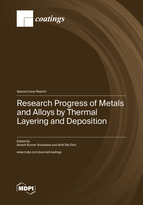Research Progress of Metals and Alloys by Thermal Layering and Deposition
A special issue of Coatings (ISSN 2079-6412). This special issue belongs to the section "Surface Characterization, Deposition and Modification".
Deadline for manuscript submissions: 30 June 2024 | Viewed by 15204
Special Issue Editors
Interests: additive manufacturing; metal additive manufacturing; material processing; material characterization
Special Issues, Collections and Topics in MDPI journals
Interests: additive manufacturing; 3D printing technologies; metal matrix composites; nano composites; friction stir processing; friction stir additive manufacturing; non-conventional machining processes
Special Issues, Collections and Topics in MDPI journals
Special Issue Information
Dear Colleagues,
In manufacturing, it has been observed that lots of problems are associated with the wear and corrosion of parts, which becomes the main reason for the failure of the complete product. The manufacturing industry needs the attention of researchers to focus on the development of functionally graded materials which can sustain high temperatures and high wear and corrosion. The design of material leads to the modification of their local properties according to their engineering application. Coating is one of the suitable techniques to improve the wear, corrosion and overall life of the component. In addition to it, the methods such as additive layer coatings, friction stir coating, friction stir layer deposition and functionally graded materials are some alternative options to overcome the defects such as high wear and corrosion of the mating parts of the automobile and to improve the mechanical and microstructural properties. Plastic deformation techniques such as severe plastic deformation (SPD) and friction stir processing (FSP) are some key parameters to enhance the overall performance of the material against the wear, tear and corrosion behaviour of the material. The dynamic recrystelization process and lattice dislocation phenomenon of the SPD and FSP process refine the grains and increases the larger number of grain boundaries, hence improving the hardness and strength also. This Special Issue of Coatings is focused on such coating techniques and their microstructural, mechanical, wear, corrosion and thermal characterization.
Therefore, we are inviting the submission of full-length original articles and reviews for this Special Issue of Coatings, titled “Research Progress of Metals and Alloys by thermal layering and deposition”, aiming to cover the scientific knowledge in this area and discuss topics of interest to readers.
In particular, the topics of interest includes but are not limited to:
- Coating Materials;
- Wear- and corrosion-resistant coating;
- Friction stir coatings;
- Composite coating;
- Friction stir deposition;
- Nano-structured coatings;
- Micro-structured coatings;
- Thermal layering deposition;
- Physical Vapor Deposition (PVD) Coating;
- Chemical Vapor Deposition (CVD) Coating;
- Micro-Arc Oxidation (MAO) Coating;
- Electrodeposition Coating;
- Electrolytic Deposition (ELD) Coating;
- Electrophoretic Deposition (EPD) Coating;
- Sol-gel Coating;
- Thermal Spray Coating;
- Plasma Spray Coating;
- Cold Spray Coating;
- Arc Wire Spray Coating;
- Warm Spray Coating;
- Microstructural, mechanical, thermal, wear and corrosion characterization of coatings, deposition and processing.
Dr. Ashish Kumar Srivastava
Dr. Amit Rai Dixit
Guest Editors
Manuscript Submission Information
Manuscripts should be submitted online at www.mdpi.com by registering and logging in to this website. Once you are registered, click here to go to the submission form. Manuscripts can be submitted until the deadline. All submissions that pass pre-check are peer-reviewed. Accepted papers will be published continuously in the journal (as soon as accepted) and will be listed together on the special issue website. Research articles, review articles as well as short communications are invited. For planned papers, a title and short abstract (about 100 words) can be sent to the Editorial Office for announcement on this website.
Submitted manuscripts should not have been published previously, nor be under consideration for publication elsewhere (except conference proceedings papers). All manuscripts are thoroughly refereed through a single-blind peer-review process. A guide for authors and other relevant information for submission of manuscripts is available on the Instructions for Authors page. Coatings is an international peer-reviewed open access monthly journal published by MDPI.
Please visit the Instructions for Authors page before submitting a manuscript. The Article Processing Charge (APC) for publication in this open access journal is 2600 CHF (Swiss Francs). Submitted papers should be well formatted and use good English. Authors may use MDPI's English editing service prior to publication or during author revisions.
Keywords
- experimental testing
- microstructural characterization
- numerical modelling
- coating materials
- friction stir coatings
- composite coating
- nano-structured coatings
- micro-structured coatings
- thermal layering deposition
- physical vapor deposition (PVD) coating
- chemical vapor deposition (CVD) coating
- micro-arc oxidation (MAO) coating
- electrodeposition coating
- electrolytic deposition (ELD) coating
- electrophoretic deposition (EPD) coating
- sol-gel coating
- thermal spray coating







